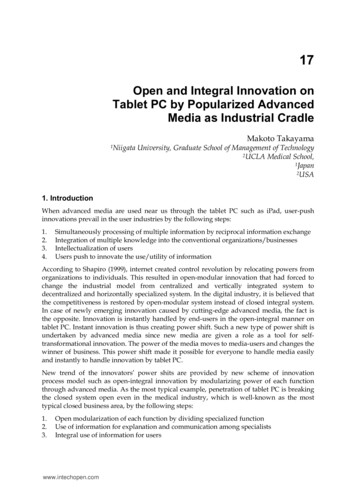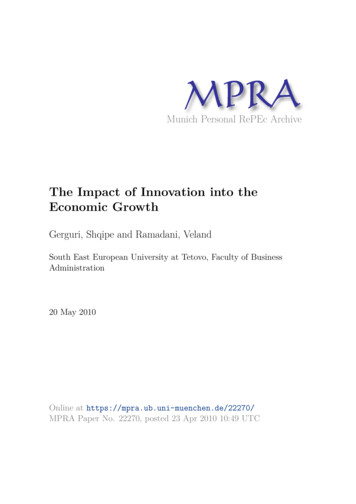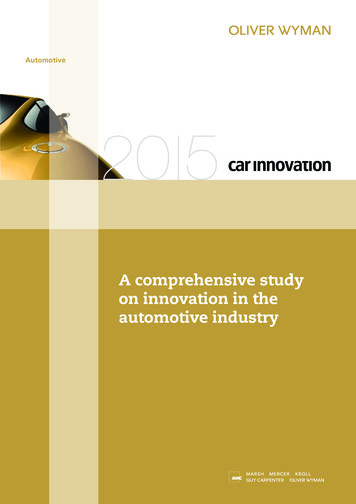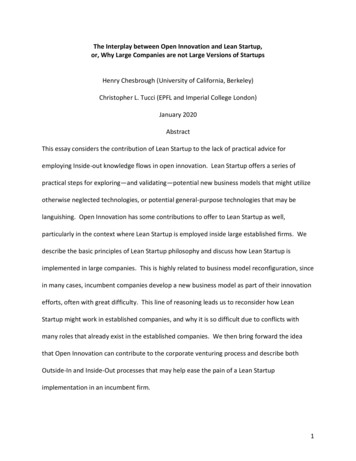
Transcription
17Open and Integral Innovation onTablet PC by Popularized AdvancedMedia as Industrial CradleMakoto Takayama1NiigataUniversity, Graduate School of Management of Technology2UCLA Medical School,1Japan2USA1. IntroductionWhen advanced media are used near us through the tablet PC such as iPad, user-pushinnovations prevail in the user industries by the following steps:1.2.3.4.Simultaneously processing of multiple information by reciprocal information exchangeIntegration of multiple knowledge into the conventional organizations/businessesIntellectualization of usersUsers push to innovate the use/utility of informationAccording to Shapiro (1999), internet created control revolution by relocating powers fromorganizations to individuals. This resulted in open-modular innovation that had forced tochange the industrial model from centralized and vertically integrated system todecentralized and horizontally specialized system. In the digital industry, it is believed thatthe competitiveness is restored by open-modular system instead of closed integral system.In case of newly emerging innovation caused by cutting-edge advanced media, the fact isthe opposite. Innovation is instantly handled by end-users in the open-integral manner ontablet PC. Instant innovation is thus creating power shift. Such a new type of power shift isundertaken by advanced media since new media are given a role as a tool for selftransformational innovation. The power of the media moves to media-users and changes thewinner of business. This power shift made it possible for everyone to handle media easilyand instantly to handle innovation by tablet PC.New trend of the innovators’ power shits are provided by new scheme of innovationprocess model such as open-integral innovation by modularizing power of each functionthrough advanced media. As the most typical example, penetration of tablet PC is breakingthe closed system open even in the medical industry, which is well-known as the mosttypical closed business area, by the following steps:1.2.3.Open modularization of each function by dividing specialized functionUse of information for explanation and communication among specialistsIntegral use of information for userswww.intechopen.com
3804.New Technologies – Trends, Innovations and ResearchOpen but integral use of information for everyone’s ordinary life assistanceIn conclusion, the industrial structure is converted to open-integral through openmodularizing power of the advanced media, on the basis of user-push innovation.Especially in case of medical industry, it comes to have a crucial function as industrialcradle. Industries of the next generation arise because the medical business becomes aplatform where the related industry is strongly drawn.This chapter also described the mechanism of win or loss in the new born market. Thistheory could clarify the reason why Apple could get success in developing platform bycombining modules and why other firms failed? On the whole, win or loss in the new bornmarket has a predetermined and preset agenda before starting competition.2. Instant innovation on tablet PCAccording to McLuhan (McLuhan and Fiore, 1967), "The medium is the message".McLuhan shoots down the idea that people construct meanings and transfer thesemeanings through a medium. After becoming the age of internet, the myth of internet hasbeen believed, that internet is the most powerful medium yet invented. Although internethas penetrated into our everyday life, its utility has not yet practically improved in ourreal life, unless internet changes the way. With the advent of iPad in 2010, various ways ofuse on the internet expand and accordingly strangers separated by great distances cangather to engage one another in the same contents for the possible improvement andpractical application of various technologies not merely related to IT technology. For thefirst time ever in the internet era, this gives these media the allure of a new dimension forthe progress in our realistic life. It's been a beyond internet era where technologyprogressed remarkably and life was enriched by the spread of media through tabletterminals such as iPad, tablet PC etc. This phenomenon could be compared to onlinegames on the internet, strangers separated by great distances can gather in a world ofvirtual reality to engage one another in contests and battles of every description. Thischapter shows that internet media have been drastically being outdated by the newgeneration of smart phones such as iPad in 2010.2.1 Change of the role of medium2010 is said to mark the "first year of iPad (Nikkei Business, Jan. 18, 2011). This tablet PC isextremely easy to use even for baby or elderly. It brought many advantages to everyday life;extension of human capability, resolution of problem caused by information asymmetry and,popularization of use of cutting-edge high-tech media and high technology. According toShapiro (1999), internet caused control revolution by relocating powers from organizations toindividuals. This is apparently caused by power shift since controllability of information was asource of the power in organizations in the past. In fact, information has been still controlled indictatorial states. At that time, internet was simply a tool for distributing information fromorganizations to individuals. Media were therefore thought to mediate the information fromone to another in the past. This situation is coming to an end. After the era of tablet PC, the roleof media has been changed from intermediate to creators. Regardless whether those in powerlike it or not, media make the move fast and exercise initiative for changing the power. Mediahave changed the role from power holders to power dispersants.www.intechopen.com
Open and Integral Innovation on Tablet PCby Popularized Advanced Media as Industrial Cradle3812.2 Extension of human capabilityThe medium is nowadays furthermore playing a novel role for human perception as notonly passive message but also proactive one. Cutting-edge media (advanced media) arepenetrating to everyday life rapidly, and the ruler of medium is changing from theconventional major to the public. The medium exercises much more influence to not onlycontents of media but also everything including human activity in the human life. This owesto expansion of capability of new medium itself, since the newly emerging cutting-edgemedia are expanding the contents of the message beyond human perception. According toMcLuhan (McLuhan and Carpenter, 1960, McLuhan, 1964, McLuhan, M. & McLuhan, E.,1988), the sociological role of medium is “expansion of the human being”. This theorycentered on the idea of technology expanding the realm of human knowledge andexperience. After 2010, it has actually started exceeding the limit of the human capabilitywith the function of the advanced media. Tablet PC started expanding the realm of messagebeyond the human perception. Those phenomena are symbolized by virtual reality (VR)human interface, for examples, VR simulation, augmented virtuality, augmented reality,ultra realistic communication and so on. Augmented Reality (AR) displays in a generalsense, within the context of a Reality-Virtuality (RV) continuum, encompassing a large classof "Mixed Reality" (MR) displays, which also includes Augmented Virtuality (AV)(Miligram et al., 1994).2.3 Counter measure against principle-agent problem caused by asymmetricinformationNext issue of the change is how to remove the barrier of understanding of information.Information is not equally distributed to everyone even if the same information is transferredor given. Any distribution method of information cannot avoid the problem of asymmetry ofinformation. Information asymmetry creates an imbalance of power in transactions which cansometimes cause the transactions for the inferior to go awry in the market or transaction. In2001, the Nobel Prize in Economics was awarded to George Akerlof, Michael Spence, andJoseph E. Stiglitz for their analyses of markets with asymmetric information. In accordancewith this hypothesis, the major has kept a leading position in the market by creating imbalanceof the power. Problems caused by these examples are adverse selection and moral hazard inthe market or society. Information asymmetries most commonly cause principal-agentproblems. Typical case is power relationship between patient with a fatal disease and surgeonin the operation room. As a solution of this case, advanced media are actually disclosing orrevealing the happening in the operation room.2.4 Popularization of advanced technology through advanced mediaBy extending human capability, man could select and use the necessary informationthrough advanced media. In other words, advanced media become to mediate the selectionand the use of information. This leads to attenuating the influential power of market playerfor innovation, since user could select the best for him by himself.If cutting-edge high technology is popularized by advanced media, user could find andselect directly the best way of using. This means that the diffusion rate of cutting-edge hightechnology is greatly accelerated by popularized media. When advanced media are usedwww.intechopen.com
382New Technologies – Trends, Innovations and ResearchNear us through the tablet PC such as iPad, user-push innovations prevail in the userindustries by the following steps:1.2.3.4.Simultaneously processing of multiple information by reciprocal information exchangeIntegration of multiple knowledge into the conventional organizations/businessesIntellectualization of usersUsers push to innovate the use/utility of informationAccording to Cowhey and Aronson (2008), innovation in ICT fuels the growth of the globaleconomy. The diffusion of internet, wireless, and broadband technology, growingmodularity in the design of technologies, distributed computing infrastructures, and rapidlychanging business models signal another shift. Attributing to a path breaking action oftablet PC, new technology is emerging in the field of research and immediately developedon tablet PC. Once innovative application is tested and confirmed, innovation ends up inwidespread use and instantly popularized.Rogers (1962, 2003) explains how new ideas spread via communication channels over time.Such innovations are initially perceived as uncertain and even risky. To overcome thisuncertainty, most people seek out others like themselves who have already adopted the newidea. Thus the diffusion process consists of a few individuals who first adopt an innovation,then spread the word among their circle of acquaintances. Such a diffusion process ofinnovation typically takes months or years. Becoming internet era in the 1990s, use of newtechnology may have spread more rapidly than before since internet is changing the verynature of diffusion by decreasing the importance of physical distance between people.Internet has transformed the way of communication and adoption of new ideas.Tablet PC changed the mode of diffusion of innovation and the process of adoption oftechnology. Advanced media have opened the window for experimental and direct use byusers. Innovative technology is instantly adopted once utility is recognized by users. Instantinnovation could remove the gap between experiment and adoption of innovation. Instantinnovation accelerates the frequency of feasibility study extremely and increases the numberof trial-and-error. Innovators are not corporate actors or opinion leaders but also end-users.3. Modularity in the healthcare businessHealthcare business requires expertness and know-how. For this reason, each expertise isoriginally divided into each specialized functional division or firm. To put it more preciselyin the concrete, hospital has two primitively specialized functions to diagnose and treatpatients. They are integrated into one synchronized activity by combining therapy anddiagnosis. In this way, healthcare business consists of modularized parts from thediversification of specialties. These components are integrated at hospital by unifiedactivities for treating each patient. By rapid penetration of advanced media, various barriersfor integration are rapidly conquered. It owes to integrative function of tablet PC especiallyby rapid progress in diffusion of iPad among physicians.3.1 Modularity of expertise as a source of competitive advantageIn today‘s information-rich environment, companies can no longer afford to rely entirely ontheir own ideas to advance their business, nor can they restrict their innovations to a singlewww.intechopen.com
Open and Integral Innovation on Tablet PCby Popularized Advanced Media as Industrial Cradle383path to market. According to Henry W. Chesbrough (2003), the traditional verticalintegration model for innovation has been becoming obsolete. Open-modular innovation isbelieved to be the post 20 century’s firms‘ success model since it leverages internal andexternal sources of ideas and takes them to market through multiple paths.Baldwin and Clark (2000) explained the merits of modularization, as follows:1.2.3.Expand controllable capability with a minimum of complexity, which builds complexproducts from smaller subsystems that can be designed independently yet functiontogether as a whole.Save time and mutual adjustment by the effect that modularity freed designers toexperiment with different approaches, as long as they obeyed the established designrules.Manage uncertainty effectively.To split complex products into modules increases the likelihood of innovation by combiningproducts and services of the best of several prototypes (BOB: Best of Breed). This will be ableto choose the most suitable option for many. It means that complex problem is transformedinto simple multi-option choice question. In 21 century, this control system has apparentlyacquired competitive advantage that overcome 20 century’s manufacturing and R&D modelprevailed among traditional big firms.3.2 Modularity of healthcare business by high-tech cutting edge mediaWith introduction of IT and the development of digitalization, work assignments have beensub-divided based on specialty in computer, automotive, telecommunication and powerindustries. Before common industry became modularized, each function of healthcarebusiness has been already specialized based on professional, from cleaning in a laundry todiagnosis in a laboratory and treatment in a consulting room. Table.1 shows the ratio ofoutsourcing at the hospital in Japan. More than 90% of laboratory test such as examinationof blood sample has been already outsourced in 20th century. As a recent world-wide trend,collecting patient data or ordering drugs and lab tests using handheld devices can be veryeffective in reducing errors. iPad has rapidly penetrated and come into general usage forsecurity and support at hospital.LinenDisposition of wasteLaboratory testCleaning serviceFood service operationAdministrative and clericalsupportSterilization and disinfectionpracticeCommodities .9%95.5%81.7%62.3%23.1%31.8%14.3%20.7%0%16.8%Table 1. Trend of outsourcing at hospital in Japan (Weekly Diamond, 2010)www.intechopen.com
384New Technologies – Trends, Innovations and ResearchHealthcare business consists of modularized parts for the purpose of the diversification ofspecialties. These components are integrated at hospital for the activity of treatment andpromote to integrate the healthcare enterprise as indicated by initiative of RadiologicalSociety of North America. In contrast with the move of healthcare industrial standard, themedical treatment in clinical practice did not open its system to outside, rather protect to beopened and resisting the order or restriction asked by the Health Authorities in the open.Furthermore, extremely high specialty has fixed power of majors in the market due to lackof new entry from another sector, although major loses the market share in case a newmarket is created by a product or business that competes indirectly or neutrally with themajor players in the existing market as described in Chapter 4.Practical applications of high-tech cutting-edge media are in progress for diagnosis andmedical treatment in many situations. Local medical service is seriously suffering from ashortage of medical doctors. By modularization of physicians’ expertise, it is graduallybecoming possible to reconstruct a total healthcare system in a remote spot or even in space(Akiyama, 2008).3.3 Instant innovation on tablet PCIn case of modular product, simple modularization became impedance to expanding itsperformance drastically. However, using a tablet PC as window of cutting-edge media, usercould explore the possibility for practical application directly. While maintaininginteroperability and compatibility, as shown in Figure 1, user could easily and directly testthe utility of various sets of integral parts in the open-modular by trial and error. On tabletPC, innovation happens instantly.IntegralproductModularOpenIntegralClosed Modularproduct Cutting-edge mediaMedical Open-modular& integral Fig. 1. Structure change of mode of development on tablet PCA variety of practical application is in progress at hospital. Remote diagnostic system andtherapeutic equipment are already developed by integrating modular parts. Surgical robotsalso explore the limit beyond human capability by precise and automated manipulation. Forcommunicating or checking the operation, iPad plays a central role.Healthcare industry is mostly dependent on information. Among many information devices,almost doctors are Mac lovers. Because of this, iPad is penetrated into ordinary use amongphysicians. iPad and iPhone exceeds 80% of the share among physicians including generalpractitioner (QLife, 2010). iPad has rapidly gained popularity and been quickly acceptedamong physicians. More than half of doctors have already used as a standard tool, asfollows:“iPad/iPhone revolutionize medical services” in Nursing Journal ”Kangogaku Zassi”,December, 2110.www.intechopen.com
Open and Integral Innovation on Tablet PCby Popularized Advanced Media as Industrial Cradle1.2.3.4.5.6.7.8.9.385Review or check digitized diagnostic image.Clinical records (Takahashi, 2010)View Attachments (Horinaga, 2010)Explain to the patient (Miyagawa, 2010)Description of the next-generation medical treatment (Sugimoto, 2010)Post-graduate clinical training (Sakai et.al., 2010)Description preoperative anesthesia (Seino et.al., 2010)diagnostic imaging (Suzuki, 2010)Home medical care (Toya, 2010)Considering many application of agile idea by users, innovation model on tablet PCconverts the innovation path from prototype development to launch as shown in Fig. 2. Inthe conventional innovation model, how to innovate platform with keeping agility is thebiggest issue. Tablet PC provides users with platform and therefore develop deepdifferentiating capabilities. Managers do not need to care for anything except keeping watchfor the progress by various uses experimented by many end-users.On tablet PC, idea is directly and instantly confirmed by practical use as an experimentaltrial, this facilitates the speed of innovation. Most important change is to make the value ofpower meaningless. Majors cannot impede entry from another sector.Direct use model on tablet PCIn this model: Experiment Stage practical useIdea 1experimentpracticaluseIdea 2experimentimprove toIdea 2’Idea 2’experimentpracticaluseFig. 2. Conversion of innovation path on tablet PCExemplary case is EHR (Electronic Health Record). EHR has easily made by generalpractitioners on iPad platform. This has been prevented by EHR vendors such as IBM in theUS, Fujitsu in Japan etc. If common packaged software dominates in hospital, users do notneed vendor. From view points of hospital or physicians, they cannot reveal the fault ormistake since accidents happen very often during operation or patients care. Both vendorand physicians share mutual interests to obscure the true nature in hospitalization. Theydisguise fictitiously lack of their efforts and commoditize EHR as a justified reason to beindependent of the professionals in each facility.This results in the very low levels of adoption of EHRs in U.S. hospitals. According to recentsurvey by Ashish K. Jha et.al.(2009), only 1.5% of U.S. hospitals have a comprehensiveelectronic-records system (i.e., present in all clinical units), and an additional 7.6% have awww.intechopen.com
386New Technologies – Trends, Innovations and Researchbasic system (i.e., present in at least one clinical unit). Computerized provider-order entryfor medications has been implemented in only 17% of hospitals. Larger hospitals, thoselocated in urban areas, and teaching hospitals were more likely to have electronic-recordssystems. Respondents cited capital requirements and high maintenance costs as the primarybarriers to implementation, although hospitals with electronic-records systems were lesslikely to cite these barriers than hospitals without such systems. Although Japanese medicalcommunity is recognized to be protected stronger than the US, 20.7% of Japanese hospitalshave EHR system (Seed Planning, 2010) and the number is much higher compared to 1.5%of the US hospitals. These low numbers symbolize the result of resistance to the objectivegoal of the Authorities.3.4 Tablet PC as platform of experiment & useWhy tablet PC has penetrated into our life beyond our expectation? Why tablet PC hasextreme influences to change the fixed idea or to overwhelm major firms’ impedance soquickly? All happening is derived the change of the position of maker and user, becausetablet PC was simply used as platform on which users gather. Although end-users have notwant test product so much utility, on this platform their unaware dream of real wants couldcome true. This fact is narrated by Steve Jobs, founder of Apple Inc., “Only thing to do wasto leave product intact. Competitors did gang up on product filled with junk.”The important distinct characteristics of tablet PC platform are completely different fromconventional platform. Base of conventional or authentic platform is modularization and defact standardization. Old platform strategy is apparently for major players to build successin the market. For this purpose, product is the first and utility is followed. This assumptionis set in mind and therefore it has been a cause for majors to stifle innovation.According to Gawer and Cusumano (Gawer, A & Cusumano,M.A., 2002), firm mustinnovate internally to succeed, yet its success may equally depend on correspondinginnovations by external firms. Under such a tough competitive situation, some firms havedeveloped strategies that have made them industry‘s powerhouses and world-classinnovators. They were, so to say, platform leaders. By becoming platform leaders,companies could continue to provide the technological foundation on which other products,services, and systems are built. Platform leaders have orchestrated industry innovations tosupport their products and, in the process, established dominant market positions.Cusumano distils six enduring principles for success as platform leaders (Cusumano, M.A.,2010). The first two principles are platforms (not just products), and services, for productfirms. These are relatively new and broader ways of thinking about strategy and businessmodels. The other four are capabilities (not just strategy), the "pull" concept, economies ofscope, and flexibility (not just efficiency). All contribute to agility, which is a mix offlexibility and speed. They are also essential to a new world dominated by platforms andtechnology-enabled services.Unfortunately to platform leaders, what happened for real is beyond their thought andformer success pattern till 2010, after tablet PC appeared. After that time, any firms couldnot become powerhouse by agile management in the turbulence. Table 2 summarizes themajor different points of tablet PC platform from conventional platform theory.www.intechopen.com
Open and Integral Innovation on Tablet PCby Popularized Advanced Media as Industrial Cradle1)Management control2) Autonomy3) Intention4) Experiment & use5) Powerhouse6) Initiative7) Concern8) Actor for innovationTablet UserUtilityPopularized387Conventional platform theoryEssentialCompelledStrategicLinear or concurrentCentralize as powerhousePlatform LeaderProductUser or firmTable 2. Difference of tablet (PC) platform from conventional platform1.2.3.4.5.6.7.8.Management controlNo management: management is rather evil. Market is never controlled by major firms.Autonomy“Trial and error” is not compelled to do by firm but voluntarily made by users.IntentionEvery innovative opportunity are tried voluntary, neither compelled nor intentionally.Experiment & useExperiment and use are reciprocally and simultaneously made. This means they arecoupled with feasibility test by end-user. Agile management becomes meaningless.PowerhouseIt impedes the challenge to the new opportunity to become powerhouse for centralizedto other firms, although it was essential to get the position as platform leader in theconventional platform model. From new tablet platform theory as afore-mentioned,conventional management model lose the role. It is rather evil to stifle the marketpossibility.InitiativeWho has initiative for new product development? On tablet PC platform, leader isneither major nor firm but user.ConcernFirm’s most concern is apparently product and its sales. People have forgotten that weare not interested in product itself but its utility to improve something in the life. Thus,major concern has shifted from product to utility.Actor for innovationWe did not doubt the process of commercialization or development owes to mutualcommunication between user and firm. Opposite to such an assumption, developmentand use of product is made voluntarily and coupled with users since they can input orimprove the method for use by themselves on tablet PC platform. Innovation isseparated from the first-mover to user. Actor for innovation is popularized.Before 2010, platform was provided by firms for the purpose of their product development.Becoming tablet PC era, the role of platform is changed from passive to proactive. Peoplecould handle their idea and information to meet their own utility. Platform has become aplace for life and work on which everyone has been building his product and/or business.Furthermore, advanced media intermediate the commitment of user to innovation.www.intechopen.com
388New Technologies – Trends, Innovations and Research4. Absolute win or unavoidable loss in industry: Why Apple could launchtablet PCMany existing major businesses have failed in seemingly promising development projectsespecially of innovative products or businesses. Their extensive and preceding investments forR&D or facilities, including those for establishing new laboratories or huge infrastructures, didnot prevent newcomers with different backgrounds from winning their market shares. Thetypical feature of the investment is prioritized and authorized by top management among thehigh tech related industries in common. Even with knowledge of new technologies, productsand markets at the same level as their competitors, majors will certainly lose under someconditions, while winning under others. Apple’s iPod explains such fate of success and failure.Sony once became the No.1 player in the world market by Walkman; Sony denied the newdown-load music market just at top management decision meeting in 1999 before launch ofiPod. Apple did not have any music device. In 2000, Apple’s PC business could not recover inspite of launch of a series of new model of Apple computer. While Apple did not standvirtually any chance of success about PC business, it made a desperate bid by iPod. Duringmarketing iPod, Apple could learn platform business. iPad is launched as a fusion device ofiPod, iPhone and PC. In fact, Apple did not have inventory since the first order is far from thesales perspective. If Apple were a strong market leader, it would deny tablet PC.4.1 Win or loss in the new born marketAs a typical case of high-tech related market, in the applications of the recombinant DNAtechnique, fate is separated without relation to the efforts and power. Success and failure isinvisibly determined just like manipulated by invisible God’s hands regardless of theirendeavors by fate. Under the prevailing bio-tech era in 1980s, all related firms hadestablished bio-tech institutes. This bio-tech institute boom is not only limited to life sciencerelated firms such as pharmaceuticals, beer, fermentation etc. but also absolutely unrelatedfirms in such industries as chemical, textile, food, steel, electrical industry etc. All businesseshave believed still now that establishing only institute could strike gold mine from the hugeunveiled markets.The fate of win or loss were opposite, as shown in Table 3. New Product Developments(NPDs) conducted by agricultural majors were successful in excluding newcomers from therecombinant plants market, while no pharmaceutical majors were able to commercializerecombinant drugs, nevertheless, large-scale R&D programs are dedicated in laboratories.Typical common phenomena were all majors never doubted that their capability andknowledge was the top-tiered in the existing market.Recombinant plantsRecombinant pharmaceuticalsExisting businesses’resultComplete VictoryUnavoidable LossWinning business sectorAgro-businessPharmaceutical businessTable 3. Fate of major businesses in the new born market of recombinant bio-productsMeanwhile, the chemical industry, once seen as the leader in commercializing bio-products,has shown a general tendency of divestiture of bio-businesses, including the pharmaceuticalbusiness. Those new companies usually focus their re
17 Open and Integral Innovation on Tablet PC by Popularized Advanced Media as Industrial Cradle Makoto Takayama 1Niigata University, Graduate School of Management of Technology 2UCLA Medical School, 1Japan 2USA 1. Introduction When advanced media are used near us through the tablet PC such as iPad, user-push










